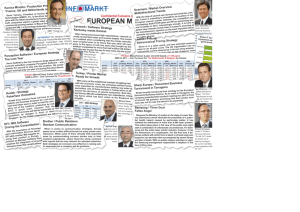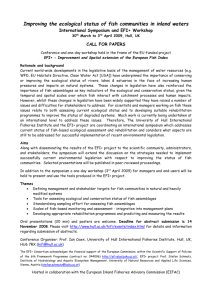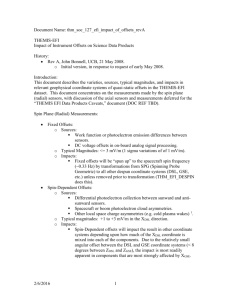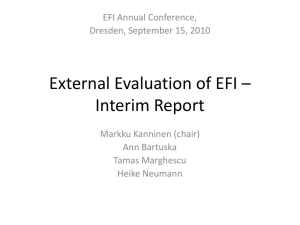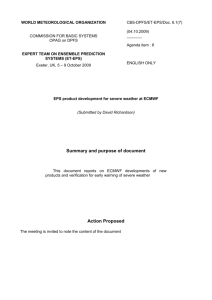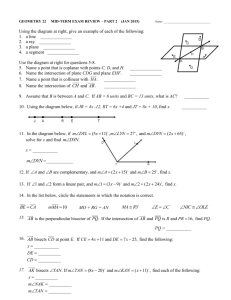The Benefits of Economic Freedom
advertisement
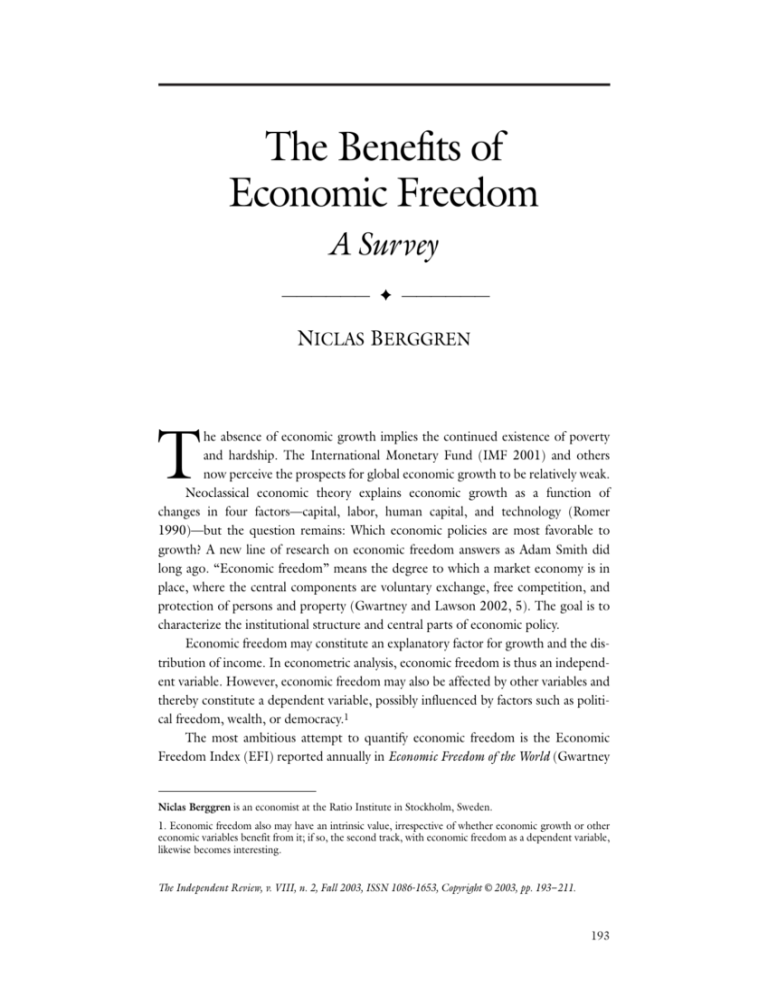
The Benefits of Economic Freedom A Survey —————— ✦ —————— NICLAS BERGGREN T he absence of economic growth implies the continued existence of poverty and hardship. The International Monetary Fund (IMF 2001) and others now perceive the prospects for global economic growth to be relatively weak. Neoclassical economic theory explains economic growth as a function of changes in four factors—capital, labor, human capital, and technology (Romer 1990)—but the question remains: Which economic policies are most favorable to growth? A new line of research on economic freedom answers as Adam Smith did long ago. “Economic freedom” means the degree to which a market economy is in place, where the central components are voluntary exchange, free competition, and protection of persons and property (Gwartney and Lawson 2002, 5). The goal is to characterize the institutional structure and central parts of economic policy. Economic freedom may constitute an explanatory factor for growth and the distribution of income. In econometric analysis, economic freedom is thus an independent variable. However, economic freedom may also be affected by other variables and thereby constitute a dependent variable, possibly influenced by factors such as political freedom, wealth, or democracy.1 The most ambitious attempt to quantify economic freedom is the Economic Freedom Index (EFI) reported annually in Economic Freedom of the World (Gwartney Niclas Berggren is an economist at the Ratio Institute in Stockholm, Sweden. 1. Economic freedom also may have an intrinsic value, irrespective of whether economic growth or other economic variables benefit from it; if so, the second track, with economic freedom as a dependent variable, likewise becomes interesting. The Independent Review, v. VIII, n. 2, Fall 2003, ISSN 1086-1653, Copyright © 2003, pp. 193– 211. 193 194 ✦ NICLAS BERGGREN and Lawson 2002).2 Since 1996, data updated yearly have been published, and the data now cover the years 1970, 1975, 1980, 1985, 1990, 1995, and 2000. These data have begun to be used in scholarly research, which has contributed to increasing our knowledge of the importance of economic freedom. Another such index is published by the Heritage Foundation in cooperation with the Wall Street Journal (O’Driscoll, Holmes, and O’Grady 2002).3 This index and the EFI are similar in their overall implications, but because the EFI has been used more extensively in academic contexts (in part because the other index goes back only to 1995 and uses more subjective variables),4 it is the focus of this article, which surveys the recent literature in the field. The Concept of Economic Freedom Economic freedom is a composite that attempts to characterize the degree to which an economy is a market economy—that is, the degree to which it entails the possibility of entering into voluntary contracts within the framework of a stable and predictable rule of law that upholds contracts and protects private property, with a limited degree of interventionism in the form of government ownership, regulations, and taxes.5 Economic freedom is distinct from political freedom (participation in the political process on equal conditions, actual competition for political power, and free and fair elections) and from civil freedom (protection against unreasonable visitations, access to fair trials, freedom of assembly, freedom of religion, and freedom of speech). The EFI is a means of measuring the degree of economic freedom by including thirty-seven components divided into five groups in an index for the years 1970 (54 countries), 1975 (83 countries), 1980 (105 countries), 1985 (111 countries), 1990 (113 countries), 1995 (123 countries), and 2000 (123 countries). The five groups are (1) size of government: expenditures, taxes, and enterprises; (2) legal structure and security of property rights; (3) access to sound money; (4) freedom to exchange with foreigners; and (5) regulation of credit, labor, and business.6 Each component is measured from 0 (“no economic freedom”) to 10 (“full economic freedom”). The index is calculated using arithmetic averages. It should be noted that the components of the EFI, as well as weighting schemes, have changed in the various editions that 2. All the data and other information are available at http://www.freetheworld.com. 3. Data and other information are available at http://www.heritage.org/research/features/index/. 4. The similarity of the indices is made clear in Caudill, Zanella, and Mixon 2000 and in de Haan and Sturm 2000. Also, in a test of the two indices for 1996, their rankings of countries correlate to 85 percent, with a 1 percent confidence interval (Hanke and Walters 1997). An early but less ambitious attempt to construct an economic freedom index is found in Scully and Slottje 1991. 5. This is a negative concept of freedom: freedom to do something without being hindered, as opposed to freedom in the sense of having access to actual opportunities to do something (Berlin 1969). 6. For a list of all thirty-seven components, see the appendix. THE INDEPENDENT REVIEW THE BENEFITS OF ECONOMIC FREEDOM ✦ 195 Table 1: Economic Freedom in a Selection of Countries in 2000 Rank Country EFI in 2000 Percentage change of the EFI in 1970–2000 1 Hong Kong 8.8 +5 2 Singapore 8.6 +19 3 United States 8.5 +21 4 United Kingdom 8.4 +45 5 New Zealand 8.2 +28 15 Germany 7.5 +3 19 Sweden 7.4 +37 38 France 7.0 +11 122 Myanmar 3.3 -27 (from 1980) 123 Democratic Republic of Congo 3.2 -35 Source: Gwartney and Lawson 2002, 61–183. Note: These countries (including the top five countries, three European nations of some importance in policy discussions, and the bottom two countries) were chosen soley to illustrate actual EFI numbers. have been published. Hence, when comparing studies, one needs to be careful to clarify which editions one uses. Table 1 presents the EFI values in 2000 for a number of countries, as well as the percentage change of the index since 1970. In absolute numbers, two small Asian countries along with the United States and the United Kingdom rank at the top. At the bottom, one finds the Democratic Republic of Congo; many other African nations rank low as well. In relative change, of the countries listed here the United Kingdom and Sweden stand at the top, whereas the countries with low initial scores have declined in economic freedom. More detailed data for the United States are presented in table 2. The U.S. scores are high across the board. Improvements have been made in all areas during the period studied, especially with regard to the size of government. The index enables researchers to carry out statistical analyses of the importance of economic freedom. Examining the construction of the index, one finds that it builds in large part on data published in secondary sources, which therefore can easily be verified. Furthermore, it is easy to assign new weights to the components of the index should one so desire. As with respect to any composite index, however, one may wonder what is really measured when a great number of separate variables are combined. Different variables VOLUME VIII, NUMBER 2, FALL 2003 196 ✦ NICLAS BERGGREN Table 2: Economic Freedom in the United States 1970–2000 Year Rank EFI Size of Legal structure Access to Freedom to govern- and security of to sound exchange with foreigners ment property rights money Regulation 1970 11 7.0 4.0 8.3 9.6 7.0 5.9 1975 3 7.3 4.8 7.9 9.2 7.7 6.7 1980 4 7.5 5.2 8.3 9.2 8.0 6.8 1985 5 7.7 6.0 8.3 9.3 7.8 6.8 1990 3 7.9 6.8 8.3 9.6 7.8 6.8 1995 4 8.3 6.9 8.6 9.7 7.9 8.3 2000 3 8.5 7.6 9.2 9.7 8.0 8.2 Source: Gwartney and Lawson 2002, 165. in an index surely have different effects on certain dependent variables. Another serious concern is the selection of variables for the index. Some might be regarded as doubtful, and some missing variables might be important. Again, however, one can recalculate and reweight to one’s choosing. Also, one can incorporate additional variables. Yet another problem is that some variables of the EFI build on survey data, which can be uncertain and arbitrary. This quality is not necessarily a reason to exclude them because they may be better than no data at all. In the final section, I note some of the avenues for further research that these and related questions suggest might be worthwhile. The Importance of Economic Freedom Economic Growth That economic freedom is an important factor accounting for economic growth is probable on purely theoretical grounds. The incentives that economic actors (entrepreneurs, innovators, financiers, industrialists, and others) face are determined in large part by the institutions in place, which, as Douglass C. North (1990) points out, can be inefficient or efficient. To the extent that the institutions stimulate actions that contribute to the production of more valuable output, they contribute to economic growth.7 Institutions that guarantee economic freedom plausibly have the capacity to provide the growth-enhancing kind of incentives, for several reasons: 7. For more on the institutional perspective, see Eggertsson 1990 and Kasper and Streit 1998. THE INDEPENDENT REVIEW THE BENEFITS OF ECONOMIC FREEDOM ✦ 197 they promote a high return on productive efforts through low taxation, an independent legal system, and the protection of private property; they enable talent to be allocated to where it generates the highest value (as argued in Murphy, Schleifer, and Vishny 1991); they foster a dynamic, experimentally organized economy in which a large amount of business trial and error can take place (Johansson 2001, chap. 2) and in which competition between different actors occurs because regulations and government enterprises are few; they facilitate predictable and rational decision making through a low and stable inflation rate; and they promote the flow of trade and capital investment to where preference satisfaction and returns are the highest. Although certain types of institutional change can be expected to have distinctly positive growth effects by introducing the kind of incentives just mentioned, institutions per se, in place over time, can exert an influence not only on the level of wealth but also on growth rates, all else being equal. In any given period, established institutions set the economic incentives and influence what economic actors do. Very high and stable economic freedom, we presume, allows a dynamic economy to function and grow, even though an increase in economic freedom from a low level might exert a much more distinct influence on the growth rate for a certain period. Furthermore, sustained high growth rates imply ultimately great wealth, and so in the long term the economic freedom that increases growth can also be expected to increase accumulated wealth. If we have theoretical reasons to expect a positive relationship between economic freedom and economic growth, does empirical evidence confirm this effect? Jagdish Bhagwati thinks it does: it is not difficult to assert that economic freedom is likely to have a favorable effect on economic prosperity, for the simple reason that the last fifty years of international experience more or less confirms the fact that wherever governments used markets more and engaged in more open policies in foreign trade and investment, indeed in more economic freedom of different kinds, their countries have tended to prosper. By contrast, those countries that turned inward and had extensive regulations of all kinds on domestic economic decision-making in production, investment and innovation, are the countries that have really not done too well. (1994, 4)8 A simple mapping by Gwartney and Lawson (2002) to a large extent supports this position, as is clear from figure 1.9 As the figure shows, the one-fifth of countries 8. See also Barro 2000. 9. See World Bank 2000. VOLUME VIII, NUMBER 2, FALL 2003 198 ✦ NICLAS BERGGREN Figure 1: Economic Freedom and Annual GDP/Capita Growth, 1990–2000 3.0 2.56 1.57 1.44 1.5 1.13 0.0 –0.85 –1.5 EFI quintiles Source: Gwartney and Lawson 2002, 20. that have had the highest economic freedom have grown considerably faster than other countries, whereas the one-fifth of countries with the lowest economic freedom have, in fact, had negative growth. A number of econometric studies corroborate this conclusion, with varying strengths and in different forms. The results should be interpreted with the usual care. Gwartney, Lawson, and Holcombe (1999), like de Haan and Sturm (2000, 2001) and Adkins, Moomaw, and Savvides (2002), find that the level of economic freedom at the beginning of the growth period studied does not contribute significantly to explaining growth, but that positive changes in economic freedom do so. The latter result is also obtained by Dawson (1998), Pitlik (2002), and Weede and Kämpf (2002). Others, however, have found that the initial level of economic freedom is positively related to growth (Ali 1997; Easton and Walker 1997; Goldsmith 1997; Dawson 1998; Wu and Davis 1999; Hanson 2000; Heckelman and Stroup 2000;10Ali and Crain 2001, 2002; Carlsson and Lundström 2002; Pitlik 2002; Scully 2002; Weede and Kämpf 2002). Even so, the findings of a positive effect of the initial level of economic freedom are generally weaker than those indicating a 10. This study identifies and uses a different weighting scheme for the EFI components, resulting in a finding that “differences in economic freedoms between nations can explain almost half of the variation in growth” (542). It does not find such a result, however, when the regular weighting schemes to generate the EFI are used. For a critique and a defense of this study, see Sturm, Leertouwer, and de Haan 2002 and Heckelman and Stroup 2002, respectively. THE INDEPENDENT REVIEW THE BENEFITS OF ECONOMIC FREEDOM ✦ 199 positive effect of increases in economic freedom, and in several cases the level effect appears statistically significant only if the change in economic freedom is also included as a variable. Some parts of the EFI might promote growth more than others. Carlsson and Lundström (2002) establish that of the seven EFI groups (in the version published in 2000), four are positively and statistically significantly related to growth (economic structure and use of markets, freedom to use alternative currencies, legal structure and security of ownership, and freedom of exchange in capital markets), two are negatively and statistically significantly related to growth (the size of government and international exchange/freedom to trade with foreigners), and one is not statistically significantly related to growth (monetary policy and price stability).11 The most surprising of these results, both from a theoretical perspective and in comparison to other empirical results,12 are the two negative relationships detected. They imply that the smaller the size of government and the more freedom to trade with foreigners, the slower the growth rate. One difficulty with aggregated measurements of this kind is that certain public undertakings may have positive growth effects, whereas others have negative effects. Hence, more studies that consider the individual components seem called for before detailed policy conclusions are drawn, especially when conclusions are presented that are at odds with many previous studies. Also, public undertakings below and above a certain level may impede growth, though they enhance growth at that middle level. That is, the relationship might be nonlinear. Other studies look at growth or gross domestic product (GDP) per capita as a function of economic freedom or its components. Overall, the results are compatible with those mentioned earlier, and a selection of these studies is presented here. Hanke and Walters (1997) study the relationship between economic freedom and GDP per capita and find it to be significant and positive. Leschke (2000) shows that, in particular, the framework within which the market economy functions and the degree of interventionism in the political process are of great importance for the wealth of nations. De Haan and Siermann (1996, 1998) make clear that the freedom index constructed by Scully and Slottje (1991) is related to growth, but only in some of the nine weighting schemes developed. Clearly, the construction of an index needs to be scrutinized. Goldsmith (1997) uses the EFI and shows that developing countries that 11. Yet another study that decomposes the index is Ayal and Karras 1998, which finds that six components have a positive and significant effect in all or some model specifications and that this effect comes about through increased total factor productivity and increased capital accumulation. Compare Heckelman and Stroup 2000. 12. As far as public-sector size and growth are concerned, Knack and Keefer (1995); Barro (1997); Gwartney, Lawson, and Holcombe (1998); and Fölster and Henrekson (2001) find a negative relationship. Ayal and Karras (1998) and Nelson and Singh (1998) find no relationship; Agell, Lindh, and Ohlsson (1997) find the negative results at the time dubious. Regarding the effects of trade on growth, see, for example, Sachs and Warner 1995 and Srinivasan and Bhagwati 2001. VOLUME VIII, NUMBER 2, FALL 2003 200 ✦ NICLAS BERGGREN better protect economic rights tend to grow faster, have a higher average national income, and have a higher degree of human well-being. Wu and Davis (1999) investigate the relationship between economic and political freedom and growth. They find that economic freedom is important for growth and that a high income level is important for political freedom. De Vanssay and Spindler (1994) use a version of the Scully-Slottje economic freedom index, which is included in a Solovian growth model, and find a positive relationship between it and economic growth. It is shown that positive rights hamper growth and that negative rights enhance it. De Vanssay and Spindler (1996) study how different constitutional factors and economic freedom (in the form of the ScullySlottje index) affect economic convergence, and they find economic freedom, of all the variables they studied, to have the strongest effect.13 As noted earlier, one needs to be careful when interpreting empirical studies, especially when sensitivity analyses are lacking and when panel data are not used. The causal relationship between variables can be unclear. For example, if a correlation between economic freedom and growth can be established, does this imply that economic freedom causes growth, or is it the other way around? On this issue, Gwartney, Lawson, and Holcombe (1999) find that economic growth is not capable of predicting future increases in economic freedom in a significant manner. Wu and Davis (1999) and Heckelman (2000) reach a similar causality result. The latter study uses the Heritage Foundation/Wall Street Journal economic freedom index and finds that the average level of economic freedom precedes growth. Farr, Lord, and Wolfenbarger (1998) identify joint causation of economic freedom and economic wealth but do not look at the causal relationship between economic freedom and growth. The most extensive test of the causal relationship between economic freedom and growth is found in Dawson’s most recent work (forthcoming). Among other things, Dawson claims that existing studies are capable of establishing a correlation between economic freedom and growth, but not capable of establishing causation. Using a Granger-causality technique, he finds that the level of economic freedom seems to affect growth, whereas increases in economic freedom are jointly determined with growth. The complexity of the relationship is made clear in the study, with some EFI components causing growth (in particular, the use of markets and property rights), some EFI components being caused by growth, and some EFI components being jointly determined with growth. 13. There is an extensive literature that looks at the importance of various institutional and policy variables for economic growth without necessarily relating to an economic freedom index, where strong protection of private property and a well-functioning judicial system are the most important variables. See, for example, Torstensson 1994; Goldsmith 1995; Barro 1997, 1999; Nelson and Singh 1998; Norton 1998a; Hall and Jones 1999; Keefer 1999; Kneller, Bleaney, and Gemmell 1999; Olson, Sarna, and Swamy 2000; Vijayaraghavan and Ward 2001; and Feld and Voigt 2002. THE INDEPENDENT REVIEW THE BENEFITS OF ECONOMIC FREEDOM ✦ 201 The most important results are summarized in table 3. No results showing that economic freedom hampers growth or that it is associated with lower GDP per capita have been reported. To the contrary, the results in general show that an increase of economic freedom exerts a positive influence on the development of economic wealth.14 Income Equality Even if it can be demonstrated that economic freedom contributes to economic growth, some people may resist policy changes that increase this sort of freedom because they fear that such changes will entail bigger income differences.15 Theoretically, it is an open question how the disposable incomes of different individuals and groups are affected by an increase in economic freedom. On the one hand, economic freedom is negatively related to income equality—in a static sense (that is, if one looks at the partial, immediate effect of a policy change) and if the income measure is disposable incomes (because the lower taxes and welfare expenditures generally associated with more economic freedom can be expected to reduce the relative position of low-income earners). On the other hand, increases in economic freedom affect the growth of gross incomes positively, and if low-income groups have a higher growth rate than others as a result of greater economic freedom, income distribution may be made more equal.16 A simple mapping by Gwartney and Lawson (2002) shows that no clear-cut relationship between economic freedom and the relative situation of the poorest seems to exist, as is clear from figure 2. Three empirical studies imply that under certain conditions the relationship is actually statistically positive. Berggren (1999) finds that the more economic freedom increased in a country between 1975 and 1985, the higher that country’s degree of income equality was around 1985. In particular, this result holds for developing countries and for the time when the policy changes brought about liberalized trade and deregulated the financial system. Equality is measured as gini coefficients and as comparisons between the income or consumption shares of lowand high-income earners. At the same time, the level of economic freedom in 1985 seems negatively related to income equality, which is probably an effect of reduced redistribution. Grubel (1998) turns the issue around and studies how income equality affects GDP per capita, economic growth, and economic freedom in sev- 14. Note that individual components of economic freedom indices can have a negative effect in accordance with results noted in the text, but these results are not dominating. 15. Two possible objections to this discussion: (1) it is based on static measures of income dispersion (the relationship between certain people at a certain point in time) rather than on a dynamic measure (the relationship between certain people over time—for example, between lifelong incomes—or the possibility for a given person to improve his income through individual actions); and (2) it presupposes that talk about “social” or distributive justice is meaningful, something that Hayek (1978) asserts is not the case. 16. For an elaborated theoretical presentation, see Berggren 1999, 206–8. VOLUME VIII, NUMBER 2, FALL 2003 202 ✦ NICLAS BERGGREN Table 3: The Effect of Economic Freedom on Growth and GDP/Capita Studies Dependent Independent Variable Variable Dawson 1998, forthcoming; Growth Gwartney, Lawson, and Holcombe 1999; de Haan and Sturm 2000, 2001; Adkins, Moomaw, and Savvides 2002; Pitlik 2002; Weede and Kampf 2002 Gwartney, Lawson, and Hol- Growth combe 1999; de Haan and Sturm 2000, 2001; Heckelman and Stroup 2000; Adkins, Moomaw, and Savvides 2002 Ali 1997; Easton and Walker Growth 1997; Goldsmith 1997; Dawson 1998, forthcoming;1 Wu and Davis 1999; Hanson 2000; Ali and Crain 2001, 2002; Carlsson and Lundstrom 2002; Pitlik 2002; Scully 2002; Weede and Kampf 2002 Hanke and Walters 1997; GDP/ Leschke 2000 cap Heckelman and Stroup 2000 Growth Growth De Vannsay and Spindler 1994 de Haan and Siermann 1996, Growth 1998 Effect Change in the EFI Significant, positive Level of the EFI Not significant Level of the EFI Significant, positive Significant, positive Level of a version of the Significant, EFI with different weights positive Level of the Scully-Slottje Significant, economic freedom index positive Level of the Scully-Slottje Mixed economic freedom index results Level of the EFI 1This study suggests joint causation. Note: EFI denotes the economic freedom index published by the Fraser Institute: see Gwartney and Lawson 2002 or the latest version. Some studies use earlier versions in which the components and weighting schemes are different. For information about the Scully-Slottje index, see Scully and Slottje 1991. The results reported in the table may not hold in every specification of the empirical tests presented in the studies. Only studies that look at the growth effects of aggregated economic freedom indices are included; for reasons of limited space, the table does not include studies that look at individual components of such indices. See the text for such references. THE INDEPENDENT REVIEW THE BENEFITS OF ECONOMIC FREEDOM ✦ 203 Figure 2: Economic Freedom and the Income Share of the Poorest 10 Percent 5 4 2.90 2.84 3 2.86 2.43 2 2.06 1 0 EFI quintiles Source: Gwartney and Lawson 2002, 20. enteen countries with a GDP per capita exceeding $17,000. The results suggest that increased income equality is related to a lower GDP per capita, lower growth, and lower economic freedom. Scully (2002) estimates a structural model and reducedform models and shows that economic freedom is beneficial for both economic growth and equality because it has a significant negative effect on gini coefficients. In addition, increased equality decreases growth, but by only a small amount.17 Other Results In addition to the variables growth, wealth, and equality, the effect of economic freedom on certain other variables has been studied. Esposto and Zaleski (1999) find that the quality of life, in terms of literacy and life expectancy, increases as economic freedom is increased, both if one compares nations and if one looks at the same countries over time. Norton (1998a) shows that countries with stronger protection of private property, as measured in the EFI, rank higher on the United Nations Human Development Index. Goldsmith (1997) uses the EFI and shows that developing countries that protect economic rights have a higher level of human well-being. 17. Other studies show, without explicitly mentioning economic freedom, that the poor in general benefit as much from economic growth as others: see Melchior, Telle, and Wiig 2000; Lindert and Williamson 2001; and Dollar and Kraay 2002. VOLUME VIII, NUMBER 2, FALL 2003 204 ✦ NICLAS BERGGREN Norton (1998b) reaches the conclusion that strong protection of privateproperty rights, as measured in the EFI, has beneficial environmental consequences. Carlsson and Lundström (2001) find that economic freedom has a hampering effect on emissions of carbon dioxide. Lundström (2002) studies how the components of economic freedom are affected by the degree of democracy in developing countries, where democracy is measured by the Freedom House indices of political and civil liberty. A positive effect of democracy on the EFI groups (as named in the 1996 version) “government operations and regulations” and “restraints on international exchange” can be detected, but no such effect was found for the groups “money and inflation” and “takings and discriminatory taxation.” Democracy does not seem to have reduced economic freedom in any dimension; in other words, more democracy seems to entail a larger scope for a market economy. De Haan and Sturm (forthcoming) find that the level of political freedom is positively related to increases in economic freedom between 1975 and 1990, a conclusion that is valid for several different measures of democracy. Dawson (forthcoming) confirms these findings but makes clear the complexity of the relationship. Spindler and De Vanssay (2002) investigate what constitutional components affect the degree of economic freedom, and they find that only a few have such an effect: bicameralism, freedom of religion, and the number of de facto veto players. Implications for Economic Policy Economic policy is generally said to aim at securing increases in national income, an acceptable distribution of income, human well-being, and certain environmental goals. The question is how all of these goals are best obtained. There is no shortage of policy proposals that purport to regulate, tax, redistribute, intervene, and fine-tune, on the assumption that such measures can give rise to a better achievement of the goals. To the contrary, policies that rely increasingly on the processes of the market economy within the framework of a stable legal system seem to influence positively, or at least are compatible with, these goals. Above all, the results imply that political decision makers ought to be very restrictive when it comes to reducing economic freedom because such restrictions bring about significant costs in several important respects. More specifically: 1. Most studies indicate that the relative size of the public sector is negatively related to growth, as discussed in more detail earlier. For countries with large public sectors, such as Sweden, which on this group of the EFI was ranked 120 out of 123 countries in 2000, this relationship implies that a reduction of public undertakings is to be recommended to the extent that growth is a primary goal. At least, this advice applies for those undertakings that have distinctly negative effects on the allocation of resources, such as THE INDEPENDENT REVIEW THE BENEFITS OF ECONOMIC FREEDOM ✦ 205 policies that influence the incentives to work, save, and invest. Similarly, countries that have small governments need to be careful not to expand them, at least not in areas with negative growth effects. 2. Free markets are conducive to growth, which is why measures such as privatization, freedom to establish new businesses, freer pricing, more flexible contract laws, and less regulation of domestic and international trade and of capital transactions are important. For example, schooling and hospitals are run as government monopolies in many countries and are in most cases heavily regulated. This government activity reduces the scope for a dynamic, growth-enhancing market process in which each new business and each new way of doing something can be regarded as an experiment in trying to achieve better consumer satisfaction than existing alternatives. Furthermore, labor markets are heavily regulated in many countries, with heavily curtailed possibilities to enter into voluntary employment contracts. The scope for reforms is substantial. 3. An impartial and strong judicial system that protects private-property rights and upholds contracts and agreements is central for a strong economic development. This factor is particularly problematic in many developing nations. 4. Monetary policy and growth seem to be only weakly connected, but the more detailed studies indicate that the effect of inflation, particularly above certain threshold levels, on growth is negative in the medium and long term (Khan and Senhadji 2000). In recent years, inflation rates in most developed nations have come down, in part as a result of greater centralbank independence. 5. In order to benefit income equality, more long-term increases in the freedom to trade and carry out financial transactions seem especially useful, especially in developing nations. Protectionism against the developing world is particularly harmful in this regard. Concluding Remarks Adam Smith argued that market processes satisfy people’s demands spontaneously. Even though he realized that free markets are not perfect, he understood that, generally speaking, they, more than any alternatives, are able to advance wealth and welfare. Theoretical arguments and empirical results make this relationship clear. Research on economic freedom is still at an early stage, however (though the roots of this approach lie in the deep insights of classical political economy), and much more remains to be done. Refined statistical tests; further development of the EFI (both the weights and the composition); continued analysis of which components of the EFI are important; both contemporary and historical case studies; stud- VOLUME VIII, NUMBER 2, FALL 2003 206 ✦ NICLAS BERGGREN ies of what determines the scope of economic freedom (which implies a need for further studies of political institutions and incentives); more carefully designed causality studies; studies of more variables that economic freedom can be expected to affect; and a continuing development of economic theory that puts the role of institutions and politics at the center of the analysis—all of these investigations remain in large part still to be done. Appendix: EFI Components Note: GCR Global Competitiveness Report; ICRG International Country Risk Guide 1. Size of Government: Expenditures, Taxes, and Enterprises A. General government consumption spending as a percentage of total consumption B. Transfers and subsidies as a percentage of GDP C. Government enterprises and investment as a percentage of GDP D. Top marginal tax rate (and income threshold to which it applies) 2. Legal Structure and Security of Property Rights A. Judicial independence: The judiciary is independent and not subject to interference by the government or parties in disputes (GCR) B. Impartial courts: A trusted legal framework exists for private businesses to challenge the legality of government actions or regulation (GCR) C. Protection of intellectual property (GCR) D. Military interference in rule of law and the political process (ICRG) E. Integrity of the legal system (ICRG) 3. Access to Sound Money A. Average annual growth of the money supply in the past five years minus average annual growth of real GDP in the past ten years B. Standard inflation variability in the past five years C. Recent inflation rate D. Freedom to own foreign-currency bank accounts domestically and abroad 4. Freedom to Exchange with Foreigners A. Taxes on international trade i. Revenue from taxes on international trade as a percentage of exports plus imports ii. Mean tariff rate iii. Standard deviation of tariff rates B. Regulatory trade barriers i. Hidden import barriers: no barriers other than published tariffs and quotas (GCR) ii. Costs of importing: the combined effect of import tariffs, license fees, bank fees, and the time required for administrative red tape raises THE INDEPENDENT REVIEW THE BENEFITS OF ECONOMIC FREEDOM ✦ 207 costs of importing equipment; 10 10 percent or less; 0 more than 50 percent (GCR) C. Actual size of trade sector compared to expected size D. Difference between the official exchange rate and the black-market rate E. International capital market controls i. Access of citizens to foreign capital markets and foreign access to domestic capital markets (GCR) ii. Restrictions on the freedom of citizens to engage in capital-market exchange with foreigners’ index of capital controls among thirteen IMF categories 5. Regulation of Credit, Labor, and Business A. Credit-Market Regulations i. Ownership of banks: percentage of deposits held in privately owned banks ii. Competition: Domestic banks face competition from foreign banks (GCR) iii. Extension of credit: percentage of credit extended to private sector iv. Avoidance of interest-rate controls and regulations that lead to negative real interest rates v. Interest-rate controls: Interest-rate controls on bank deposits or loans or both are freely determined by the market (GCR) B. Labor-Market Regulations i. Impact of minimum wage: the minimum wage, set by law, has little impact on wages because it is too low or not obeyed (GCR) ii. Hiring and firing practices of companies determined by private contract (GCR) iii. Share of labor force whose wages are set by centralized collective bargaining (GCR) iv. Unemployment benefits system preserves the incentive to work (GCR) v. Use of conscripts to obtain military personnel C. Business Regulations i. Price controls: the extent to which businesses are free to set their own prices ii. Administrative conditions and new businesses: administrative procedures are an important obstacle to starting a new business (GCR) iii. Time that senior management spends dealing with government bureaucracy (GCR) iv. Starting a new business is generally easy (GCR) v. Irregular, additional payments connected with import and export permits, business licenses, exchange controls, tax assessments, police protection, or loan applications are very rare (GCR) VOLUME VIII, NUMBER 2, FALL 2003 208 ✦ NICLAS BERGGREN References Adkins, Lee C., Ronald L. Moomaw, and Andreas Savvides. 2002. Institutions, Freedom, and Technical Efficiency. Southern Economic Journal 69 (July): 92–108. Agell, Jonas, Thomas Lindh, and Henry Ohlsson. 1997. Growth and the Public Sector: A Critical Review Essay. European Journal of Political Economy 13, no. 1: 33–52. Ali, Abdiweli. 1997. Economic Freedom, Democracy, and Growth. Journal of Private Enterprise 13 (fall): 1–20. Ali, Abdiweli, and W. Mark Crain. 2001. Political Regimes, Economic Freedom, Institutions, and Growth. Journal of Public Finance and Public Choice 19, no. 1: 3–22. ———. 2002. Institutional Distortions, Economic Freedom, and Growth. Cato Journal 21, no. 3: 415–26. Ayal, Eliezer B., and Georgios Karras. 1998. Components of Economic Freedom and Growth: An Empirical Study. Journal of Developing Areas 32, no. 3: 327–38. Barro, Robert J. 1997. Determinants of Economic Growth: A Cross-Country Empirical Study. Cambridge, Mass.: MIT Press. ———. 1999. Inequality, Growth, and Investment. Working Paper no. w7038. Cambridge, Mass.: National Bureau of Economic Research. ———. 2000. Rule of Law, Democracy, and Economic Performance. In 2000 Index of Economic Freedom, edited by Gerald P. O’Driscoll, Kim R. Holmes, and Melanie Kirkpatrick, 31–51. New York: Dow Jones. Berggren, Niclas. 1999. Economic Freedom and Equality: Friends or Foes? Public Choice 100, nos. 3–4: 203–23. Berlin, Isaiah. 1969. Four Essays on Liberty. Oxford: Oxford University Press. Bhagwati, Jagdish. 1999. Economic Freedom: Prosperity and Social Progress. Paper presented to the Conference on Economic Freedom and Development, Tokyo, June 17–18. Carlsson, Fredrik, and Susanna Lundström. 2001. Political and Economic Freedom and the Environment: The Case of CO2 Emissions. Working Paper in Economics no. 29. Gothenburg, Sweden: Gothenburg University. ———. 2002. Economic Freedom and Growth: Decomposing the Effects. Public Choice 112, nos. 3–4: 335–44. Caudill, Steven B., Fernando Zanella, and Franklin G. Mixon Jr. 2000. Is Economic Freedom One Dimensional? A Factor Analysis of Some Common Measures of Economic Freedom. Journal of Economic Development 25 (June): 17–39. Dawson, John W. 1998. Institutions, Investment, and Growth: New Cross-Country and Panel Data Evidence. Economic Inquiry 36 (October): 603–19. ———. Forthcoming. Causality in the Freedom-Growth Relationship. European Journal of Political Economy. Dollar, David, and Art Kraay. 2002. Growth Is Good for the Poor. Journal of Economic Growth 7, no. 3: 195–225. Easton, Steven T., and Michael A. Walker. 1997. Income, Growth, and Economic Freedom. American Economic Review 87, no. 2: 328–32. THE INDEPENDENT REVIEW THE BENEFITS OF ECONOMIC FREEDOM ✦ 209 Eggertsson, Thorsteinn. 1990. Economic Behaviour and Institutions. Cambridge, U.K.: Cambridge University Press. Esposto, Alfredo, and Peter Zaleski. 1999. Economic Freedom and the Quality of Life. Constitutional Political Economy 10, no. 2: 185 –97. Farr, W. Ken, Richard A. Lord, and J. Larry Wolfenbarger. 1998. Economic Freedom, Political Freedom, and Economic Well-Being: A Causality Analysis. Cato Journal 18, no. 2: 247–62. Feld, Lars P., and Stefan Voigt. 2002. Economic Growth and the Rule of Law: Cross Country Evidence Using a New Set of Indicators. Paper presented to the Public Choice Society, San Diego, March 22. Fölster, Stefan, and Magnus Henrekson. 2001. Growth Effects of Government Expenditure and Taxation in Rich Countries. European Economic Review 45, no. 8: 1501–20. Goldsmith, Arthur A. 1995. Democracy, Property Rights, and Economic Growth. Journal of Development Studies 32, no. 2: 157–74. ———. 1997. Economic Rights and Government in Developing Countries: Cross-National Evidence on Growth and Development. Studies in Comparative International Development 32, no. 2: 29–44. Grubel, Herbert G. 1998. Economic Freedom and Human Welfare: Some Empirical Findings. Cato Journal 18, no. 2: 287–304. Gwartney, James G., and Robert A. Lawson. 2002. Economic Freedom of the World: 2002 Annual Report. Vancouver: Fraser Institute. Gwartney, James G., Robert A. Lawson, and Randall G. Holcombe. 1998. The Size and Functions of Government and Economic Growth. Report to the Joint Economic Committee of the U.S. Congress, Washington, D.C. Available at http://www.house.gov/jec/growth /function/function.htm. ———. 1999. Economic Freedom and the Environment for Economic Growth. Journal of Institutional and Theoretical Economics 155, no. 4: 1–21. Haan, Jakob de, and Clemens L. J. Siermann. 1996. New Evidence on the Relationship Between Democracy and Economic Growth. Public Choice 86, nos. 1–2: 175–98. ———. 1998. Further Evidence on the Relationship Between Economic Freedom and Economic Growth. Public Choice 95, no. 3 – 4: 363 –80. Haan, Jakob de, and Jan-Egbert Sturm. 2000. On the Relationship Between Economic Freedom and Economic Growth. European Journal of Political Economy 16, no. 2: 215–41. ———. 2001. How Robust Is the Relationship Between Economic Freedom and Economic Growth? Applied Economics 33, no. 7: 839–44. ———. Forthcoming. Does More Democracy Lead to Greater Economic Freedom? New Evidence for Developing Countries. European Journal of Political Economy. Hall, Robert E., and Charles J. Jones. 1999. Why Do Some Countries Produce So Much More Output Than Others? Quarterly Journal of Economics 114, no. 1: 83–116. Hanke, Steve H., and Stephen J. K. Walters. 1997. Economic Freedom, Prosperity, and Equality: A Survey. Cato Journal 17, no. 2: 117–46. Hanson, John R., II. 2000. Prosperity and Economic Freedom. The Independent Review 4, no. 4: 525–31. VOLUME VIII, NUMBER 2, FALL 2003 210 ✦ NICLAS BERGGREN Hayek, Friedrich A. 1978. The Atavism of Social Justice. In New Studies in Philosophy, Politics, Economics, and the History of Ideas. London: Routledge. Heckelman, Jac C. 2000. Economic Freedom and Economic Growth: A Short-Run Causal Investigation. Journal of Applied Economics 3, no. 1: 71–91. Heckelman, Jac C., and Michael D. Stroup. 2000. Which Economic Freedoms Contribute to Growth? Kyklos 53, no. 4: 527–44. ———. 2002. Which Economic Freedoms Contribute to Growth? Reply. Kyklos 55, no. 3: 417–20. International Monetary Fund (IMF). 2001. World Economic Outlook: The Global Economy after September 11. Washington, D.C.: International Monetary Fund. Johansson, Dan. 2001. The Dynamics of Firm and Industry Growth: The Swedish Computing and Communications Industry. Stockholm: Royal Institute of Technology. Kasper, Wolfgang, and Manfred Streit. 1998. Institutional Economics: Social Order and Public Policy. Cheltenham: Edward Elgar. Keefer, Philip. 1999. Does One Size Fit All? Fitting Economic Reforms to Political Institutions. Journal for Institutional Innovation, Development, and Transition 3 (March): 5–14. Khan, Mohsin S., and Abdelhak S. Senhadji. 2000. Threshold Effects in the Relationship Between Inflation and Growth. Working Paper no. 00/110. Washington, D.C.: International Monetary Fund. Knack, Stephen, and Philip Keefer. 1995. Institutions and Economic Performance: Cross-Country Tests Using Alternative Institutional Measures. Economics and Politics 7, no. 3: 207–27. Kneller, Richard, Michael F. Bleaney, and Norman Gemmell. 1999. Fiscal Policy and Growth: Evidence from OECD Countries. Journal of Public Economics 74, no. 2: 171–90. Leschke, Martin. 2000. Constitutional Choice and Prosperity: A Factor Analysis. Constitutional Political Economy 11, no. 3: 265–79. Lindbeck, Assar. 2000. Swedish Economic Growth in an International Perspective. Swedish Economic Policy Review 7, no. 1: 7–37. Lindert, Peter H., and Jeffrey G. Williamson. 2001. Does Globalization Make the World More Unequal? Working Paper no. 8228. Cambridge, Mass.: National Bureau of Economic Research. Lundström, Susanna. 2002. The Effect of Democracy on Different Categories of Economic Freedom. Working Paper in Economics no. 79. Gothenburg, Sweden: Gothenburg University. Melchior, Arne, Kjetil Telle, and Henrik Wiig. 2000. Globalisation and Inequality: World Income Distribution and Living Standards, 1960–1998. Studies on Foreign Policy Issues, report 6B. Oslo: Royal Norwegian Ministry of Foreign Affairs. Murphy, Kevin M., Andrei Shleifer, and Robert W. Vishny. 1991. The Allocation of Talent: Implications for Growth. Quarterly Journal of Economics 106, no. 2: 503–30. Nelson, Michael A., and Ram D. Singh. 1998. Democracy, Economic Freedom, Fiscal Policy, and Growth in LDCs: A Fresh Look. Economic Development and Cultural Change 46, no. 4: 677–96. North, Douglass C. 1990. Institutions, Institutional Change, and Economic Performance. Cambridge, U.K.: Cambridge University Press. Norton, Seth W. 1998a. Poverty, Property Rights, and Human Well-Being: A Cross-National Study. Cato Journal 18, no. 2: 233–46. THE INDEPENDENT REVIEW THE BENEFITS OF ECONOMIC FREEDOM ✦ 211 ———. 1998b. Property Rights, the Environment, and Economic Well-Being. In Who Owns the Environment? edited by Peter J. Hill and Roger E. Meiners, 37–54. Lanham, Md.: Rowman and Littlefield. O’Driscoll, Gerald P., Kim R. Holmes, and Mary Anastasia O’Grady, eds. 2002. 2002 Index of Economic Freedom. New York: Dow Jones. Olson, Mancur, Naveen Sarna, and Anand V. Swamy. 2000. Governance and Growth: A Simple Hypothesis Explaining Cross-Country Differences in Productivity Growth. Public Choice 102, nos. 3–4: 341–64. Pitlik, Hans. 2002. The Path of Liberalization and Economic Growth. Kyklos 55, no. 1: 57–80. Romer, Paul M. 1990. Endogenous Technological Change. Journal of Political Economy 98, no. 5: S71–S102. Sachs, Jeffrey D., and Andrew M. Warner. 1995. Economic Reform and the Process of Global Integration. Brookings Papers on Economic Activity 1: 1–118. Scully, Gerald. 2002. Economic Freedom, Government Policy, and the Trade-Off Between Equity and Economic Growth. Public Choice 113, nos. 1–2: 77–96. Scully, Gerald, and Daniel J. Slottje. 1991. Ranking Economic Liberty Across Countries. Public Choice 69, no. 2: 121–52. Spindler, Zane A., and Xavier De Vanssay. 2002. Constitutions and Economic Freedom: An International Comparison. South African Journal of Economics 70, no. 6: 1135–42. Srinivasan, T. N., and Jagdish Bhagwati. 2001. Outer-Orientation and Development: Are Revisionists Right? In Trade, Development, and Political Economy: Essays in Honour of Anne O. Krueger, edited by Deepak Lal and Richard H. Snape, 3–26. Basingstoke: Palgrave. Sturm, Jan-Egbert, Erik Leertouwer, and Jakob de Haan. 2002. Which Economic Freedoms Contribute to Growth? A Comment. Kyklos 55, no. 3: 403–16. Torstensson, Johan. 1994. Property Rights and Economic Growth: An Empirical Study. Kyklos 47, no. 2: 231–47. Vanssay, Xavier De, and Zane A. Spindler. 1994. Freedom and Growth: Do Constitutions Matter? Public Choice 78, nos. 3–4: 359–72. ———. 1996. Constitutions, Institutions, and Economic Convergence: An International Comparison. Journal for Studies in Economics and Econometrics 20, no. 3: 1–19. Vijayaraghavan, Maya, and William A. Ward. 2001. Institutions and Economic Growth: Empirical Evidence from a Cross-National Analysis. Working Paper no. 001302. Clemson, S.C.: Center for International Trade, Clemson University. Weede, Erich, and Sebastian Kämpf. 2002. The Impact of Intelligence and Institutional Improvements on Economic Growth. Kyklos 55, no. 3: 361–80. World Bank. 2000. 2000 World Development Indicators [on CD-Rom]. Washington, D.C.: World Bank. Wu, Wenbo, and Otto A. Davis. 1999. The Two Freedoms, Economic Growth and Development: An Empirical Study. Public Choice 100, nos. 1–2: 39–64. Acknowledgments: The author wishes to thank Magnus Henrekson, Dan Johansson, Henrik Jordahl, Nils Karlson, Daniel B. Klein, and two anonymous referees for helpful comments, as well as the Torsten and Ragnar Söderberg Foundations (Torsten och Ragnar Söderbergs stiftelser) for financial support. VOLUME VIII, NUMBER 2, FALL 2003
